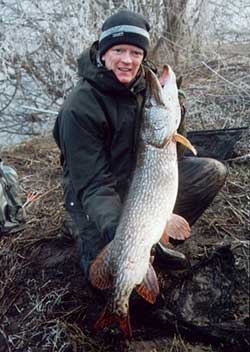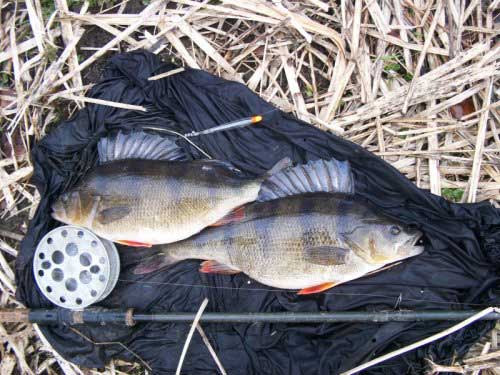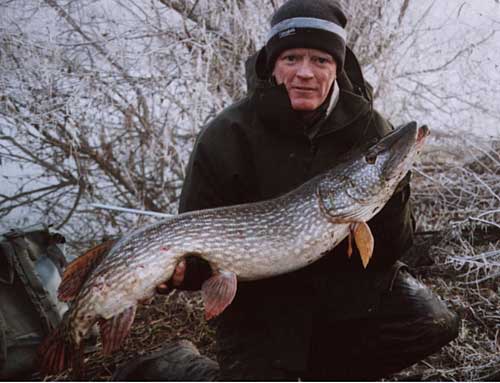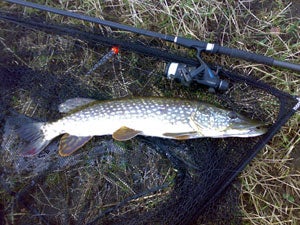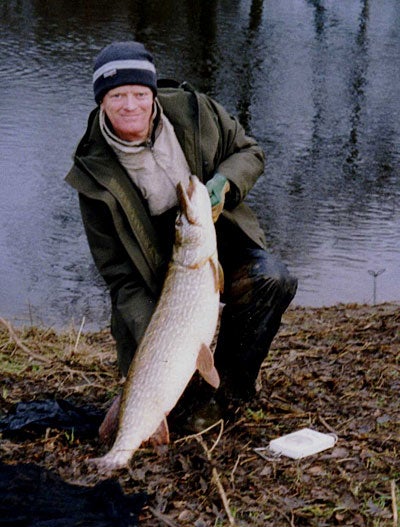Sunday morning. I’m trying to read the paper, but I can’t settle. My nerves are on edge after a hard week at work and I need to go fishing. The problem is that I can’t decide where to go. The thaw has set in and the Swale is 16 inches up and rising. It will be snow melt so despite the rise in air temperature it’s likely that the water temperature will have dropped. I spoke to Mick yesterday and the Wharfe was 10 inches up, fairly clear, and a balmy 3C. Rivercall says it’s still 10 inches up so maybe the temperature has risen a bit. The chub weren’t having it yesterday and the westerly wind means that trotting will be difficult. Hmm, what about pike? I go into the garage and have a root around in the bottom of the freezer: three pollan and some decidedly dodgy looking smelt are lurking beneath some old loaves and various boilies. They’ll do. I throw my pike gear into the back of the car, knock up some lunch and a flask and I’m off. Middle Wharfedale is Emmerdale country; the cuddly, friendly face of the Dales. Take a look at the film sequence at the start of Emmerdale and you’ll see what I mean. The smarty pants amongst you will point out that some of the shots are of the Nidd, but if you concentrate you’ll spot a cracking grayling swim on the middle Wharfe. The dale opens out below Ilkley to give a broad expanse of lush green countryside dotted with comfortable villages and prosperous market towns. Sky high property prices have pushed the locals into the council estates of Leeds and Bradford, to be replaced by smug professionals and their bleach blonde wives. But hey, at least they keep the place tidy! The Wharfe here is a classic freestone river and still retains some of its upland character. Long gravely shallows are separated by pools and slow glides. The trout of the upper reaches are giving way to grayling and chub and these are hunted by pike and a few enormous perch.
I park by an old stone bridge, shoulder my gear, and wander off downstream. It’s a couple of years since I last fished this stretch and the river has changed a fair bit. I’m looking for good chub and grayling swims. The grayling will be in the fast ‘bobbly’ water and the chub will be in the smooth glides. I know I’m pike fishing, but the secret of finding river pike is to find their food. Once you’ve done this then you won’t have far to look for a pike swim.
About 200 yards below the bridge I find a small slack at the side of a fast run. I creep up to the edge of the bank and peer into the water. I can only just see the bottom in the slightly coloured water so it’s worth a go. I plumb the depth at 30 inches, set my float slightly over-depth and swing a frozen pollan out to the edge of the crease. The slack is only about 10ft long and although the crease is quite swirly, the inside is smooth. I root in my bag for my thermometer and as I’m taking the temperature my float dips sharply. I’ve just got time to note that the water is at 4 C before the float dips again, rises and then wobbles off into the main flow. I tighten down, strike firmly and feel the solid resistance of a good pike. The fish kites out into the fast water, but I’m not too concerned as I need to play it out before attempting to land it in the tight confines of my swim. A short, but exciting struggle sees the pike in the net, where it promptly sheds the hooks as I’m taking my forceps out of the outside pocket of my bag. I take a quick look at the fish: long and thin, but still about 11lb; before easing it back into the slack.
I move off downstream and try a couple more small slacks without success, before I come to one of my banker swims, a large slack on the inside of a wide bend. I’ve had a 22-pounder from here a few years ago. The river is deeper and smoother here and it screams chub. The slack seems to have silted up a bit since I last fished it and it’s only about 3ft deep. I decide to give it a go anyway so I swing out another pollan and settle back to eat my lunch. I’m warm and comfortable, basking in the weak winter sunlight, but I still make the effort to recast to different parts of the swim over the next hour. There’s nothing doing, so I gather together my gear and trudge off. I stop to take a quick snap of a pike’s skull, a victim of otters or stranded in the field by the last flood?
About 200 yards further downstream I find another crease swim in a long, smooth glide. This swim is about 15 yards long and I plumb the depth at the head of the crease at 7ft. The crease is about 10ft out from the bank and I drop my pollan just on the edge of the slacker water. My reasoning for this is that any feeding pike will have an eye on the faster water where it’s likely that the chub will be hanging out. There’s no action for half an hour then the float dips sharply, but a run doesn’t develop. I twitch the bait, then I recast, but there’s no further interest – maybe it was a chub. I decide to move and I drop below an overhanging bush that splits the swim in two. I fish the bottom of the swim for half an hour with no interest and then cast upstream to the edge of the bush. I’m just thinking of making another move when the float twitches. This time it twitches again and a run slowly develops. I strike and hook a lively jack which leads me a merry dance around the swim. Again the fish is only lightly hooked and the hooks fall out in the net. This time I take a quick snap before returning it.
It’s getting late and I’m over a mile from my car so I decide to head back and give my banker swim half an hour on the way back. I draw a blank again, but it’s been a good day and all the tension has drained out of me – I amble contentedly back to my car with a smile on my face. Some Thoughts on Water Temperature and Feeding Behaviour There’s been a bit of discussion on the forums recently about fishes’ feeding behaviour in cold weather and the factors that affect it. I’ve written about my observations on the feeding behaviour of barbel at this time of the year and how it doesn’t seem to follow accepted ideas on the effect of water temperature. This behaviour probably applies to most fish and if we can get our heads around it we’ll be more successful. Here are my thoughts on the subject. A variety of factors affect feeding behaviour. Fish are superbly adapted to their environment and are programmed for survival. Water temperature governs the speed at which food is digested and so governs the amount of energy that can be extracted from it. Equally, low temperatures slow the fish’s metabolism and limit the amount of energy it needs. Digesting food takes energy and the fish has to invest some of its resources in order to extract energy from its food. I believe that it is likely that the fish’s nervous system also anticipates its future energy requirements and so regulates food intake. This internal programming will take into account whether the water temperature is rising or falling, the time of year, the fish’s normal temperature range, the state of the river, atmospheric pressure, etc. All these factors will be monitored constantly and the fish’s feeding behaviour adjusted accordingly. For example, a drop in water temperature in winter when coupled with the onset of a large high pressure system (a fish might not sense atmospheric pressure, but deduce it from the time of year, light levels, wind velocity, etc) might well cause a fish to cut down on its food intake as its future food requirements will decrease. With pike this might also affect the preferred size of prey fish, so they may switch from bream to roach, for example. On the other hand a drop in water temperature in spring might not have the same effect. At this time of year cold snaps don’t last for as long and the pike is gearing up for spawning. These behavioural triggers are complex, which is what makes fish behaviour so difficult to predict. It may well be at the root of periodic behavioural changes which we attribute to lunar cycles. It’s not really the fish sensing the position and phase of the moon, but subtle environmental cycles which follow lunar cycles. So what does all this mean in practice? Well from the point of view of pike fishing I think it means that it’s always worth making the effort to fish, but when conditions are likely to limit the pike’s feeding activity it pays to be mobile and actively seek out the fish. I’m not so sure about the effect of bait type and size on how successful we are as the baits that we use are generally at the bottom end of the preferred prey size for pike. This might actually be a benefit in severe conditions as pike might actually select our baits in preference to larger fish in the vicinity. Rivers are often more consistent than stillwaters in winter as fish location is easier and most of the fish holding spots are within casting range.
|
Welcome!Log into your account










